
Quick Tips
- The gentlest method of cleaning stainless steel is to simply wipe the surface with hot water and a soft, clean cloth.
- If plain water leaves behind some dirt or grease, try adding a gentle detergent to the water.
- Grease can be dissolved with rubbing alcohol on a soft cloth.
- Stubborn or burnt-on stains can be scrubbed off with a soft cloth and a paste of baking soda and water.
- If you use all the steps listed above, like I did, you might want to wait until the very end to rinse and dry the stainless steel.
- This combination of methods got my stainless steel pizza oven very clean, with the exception of some light discolored spots.
Did you know that if you wanted everything in your kitchen to be stainless steel, it would be absolutely no problem at all? It’s true: Target.com lists over 1,000 stainless steel products, including a paper towel holder and a compost keeper. Because who doesn’t want sleek, classy compost? The consumer demand for stainless steel appliances and gadgets wasn’t always so high. Just five years ago I had to search several stores to find a stainless steel colander, but today I found 15 different shapes and sizes on a single website. The spike in stainless steel’s popularity is probably due to a combination of factors: it’s hygienic, easy to maintain, and more eco-friendly than plastic. Plus, it’s shiny.
But since stainless steel appliances made the transition from restaurants and institutional kitchens to our homes relatively recently, our moms didn’t have a chance to teach us how to clean them. And even if they had, their instructions probably would have included stainless steel polish, which usually contains acids and other chemicals that aren’t very safe for people or the environment. Fortunately, harsh chemicals just aren’t necessary for making stainless steel sparkle. Several cleaning methods, listed below from least to most intensive, use nothing but all-natural household products. I recommend starting at the top, with plain water and a soft cloth, and working your way down the list if your stainless steel still looks dirty or dull.
Steps to Cleaning Stainless Steel
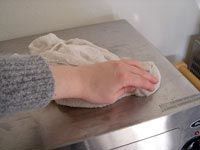 The gentlest method of cleaning stainless steel is to simply wipe the surface with hot water and a soft, clean cloth. Then dry the metal thoroughly with another soft cloth to prevent water spots. I was surprised at how much of the surface grime came off my pizza oven with just this step. When using this or any of the other methods, remember that stainless steel has a “grain”—tiny grooves running in one direction across the surface of the metal—and it’s best to clean with the grain rather than scrubbing across it. Some people will tell you that this is to avoid scratching the metal or lodging particles of dirt in the grain where they can cause rust to form. This may very well be true, but scrubbing with the grain also seems easier and more effective.
The gentlest method of cleaning stainless steel is to simply wipe the surface with hot water and a soft, clean cloth. Then dry the metal thoroughly with another soft cloth to prevent water spots. I was surprised at how much of the surface grime came off my pizza oven with just this step. When using this or any of the other methods, remember that stainless steel has a “grain”—tiny grooves running in one direction across the surface of the metal—and it’s best to clean with the grain rather than scrubbing across it. Some people will tell you that this is to avoid scratching the metal or lodging particles of dirt in the grain where they can cause rust to form. This may very well be true, but scrubbing with the grain also seems easier and more effective.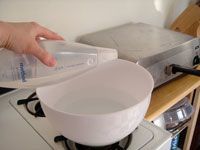 If plain water leaves behind some dirt or grease, try adding a gentle detergent to the water. I used Method’s naturally derived, biodegradable dish soap, and found that it removed a little of what water alone had missed, including some grease. If you’re cleaning stainless steel pans or tableware, this is the best method to use. Cooked-on food can usually be removed by soaking the pan in the soapy water and using a sponge with a gentle scrubbing pad. Don’t get impatient and use steel wool; it can scratch stainless steel or leave behind particles that may rust. And again, remember to rinse and hand-dry the stainless steel after cleaning.
If plain water leaves behind some dirt or grease, try adding a gentle detergent to the water. I used Method’s naturally derived, biodegradable dish soap, and found that it removed a little of what water alone had missed, including some grease. If you’re cleaning stainless steel pans or tableware, this is the best method to use. Cooked-on food can usually be removed by soaking the pan in the soapy water and using a sponge with a gentle scrubbing pad. Don’t get impatient and use steel wool; it can scratch stainless steel or leave behind particles that may rust. And again, remember to rinse and hand-dry the stainless steel after cleaning.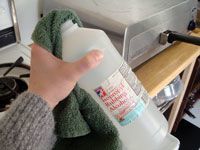 Grease can be dissolved with rubbing alcohol on a soft cloth. I was impressed with how well this took the grease off my pizza oven. Some of the thicker deposits didn’t respond to a once-over with the cloth, but I kept rubbing at them with the alcohol, and they disappeared completely within a couple of minutes. As with the other methods, it’s important to rinse off the alcohol and dry the metal to make it shine.
Grease can be dissolved with rubbing alcohol on a soft cloth. I was impressed with how well this took the grease off my pizza oven. Some of the thicker deposits didn’t respond to a once-over with the cloth, but I kept rubbing at them with the alcohol, and they disappeared completely within a couple of minutes. As with the other methods, it’s important to rinse off the alcohol and dry the metal to make it shine.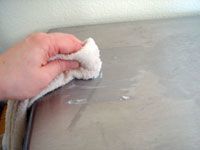 Stubborn or burnt-on stains can be scrubbed off with a soft cloth and a paste of baking soda and water.Baking soda is mildly abrasive, so it’s a good idea to test this method on a small, hidden area of the stainless steel to make sure you won’t end up with scratches. When I got to this step, I was able to remove nearly all the remaining stains and discoloration on my pizza oven. In fact, I was so happy with how it worked that I rubbed the paste all over the oven as a polish. Remember to scrub with the grain of the stainless steel and to rinse off all traces of baking soda before drying with a soft cloth.
Stubborn or burnt-on stains can be scrubbed off with a soft cloth and a paste of baking soda and water.Baking soda is mildly abrasive, so it’s a good idea to test this method on a small, hidden area of the stainless steel to make sure you won’t end up with scratches. When I got to this step, I was able to remove nearly all the remaining stains and discoloration on my pizza oven. In fact, I was so happy with how it worked that I rubbed the paste all over the oven as a polish. Remember to scrub with the grain of the stainless steel and to rinse off all traces of baking soda before drying with a soft cloth.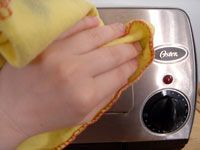 If you use all the steps listed above, like I did, you might want to wait until the very end to rinse and dry the stainless steel. I used a clean damp cloth to wipe away residue from the products I’d used, then rinsed the cloth and wiped clean water over the metal a second time. Drying left behind some streaks, so I sprayed the metal with a little of Seventh Generation’s Natural Glass & Surface Cleaner and wiped it off with a dry cloth. Incidentally, glass cleaner is also great for removing fingerprints from stainless steel that isn’t otherwise dirty.
If you use all the steps listed above, like I did, you might want to wait until the very end to rinse and dry the stainless steel. I used a clean damp cloth to wipe away residue from the products I’d used, then rinsed the cloth and wiped clean water over the metal a second time. Drying left behind some streaks, so I sprayed the metal with a little of Seventh Generation’s Natural Glass & Surface Cleaner and wiped it off with a dry cloth. Incidentally, glass cleaner is also great for removing fingerprints from stainless steel that isn’t otherwise dirty.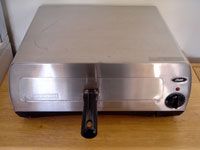 This combination of methods got my stainless steel pizza oven very clean, with the exception of some light discolored spots. Not bad, considering I’d owned it for three years and never cleaned it before. Ahem.
This combination of methods got my stainless steel pizza oven very clean, with the exception of some light discolored spots. Not bad, considering I’d owned it for three years and never cleaned it before. Ahem.
Stainless Steel Stays Stainless Naturally
Stainless steel is a steel alloy containing at least 10.5% chromium. When chromium comes into contact with oxygen in the air, it forms chromium oxide, so a thin layer of chromium oxide always sits like a skin over the surface of stainless steel, protecting it from dirt and moisture. This is what makes stainless steel “stainless,” meaning it usually comes clean easily and rarely rusts. It is not, however, impossible for stainless steel to stain or rust. If food or dirt is allowed to sit on stainless steel for a long time, it can hold moisture or acids against the surface of the metal and cause it to corrode or retain some of the color of the grime. This is why it’s important to clean stainless steel on a regular basis, even if all you’re doing is wiping it down with a clean damp cloth. And, no matter how often you clean stainless steel, you never have to worry about compromising the protective layer: fresh chromium oxide will automatically form to replace any you remove during cleaning.
Polishing Stainless Steel Naturally
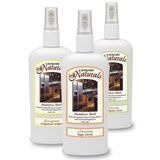 Howard Naturals Stainless Steel Cleaner is a nontoxic, vegetable-based polish. Plus, it contains essential oils and is available in three different scents. So it doesn’t just make your stainless steel shiny; it smells good doing it.
Howard Naturals Stainless Steel Cleaner is a nontoxic, vegetable-based polish. Plus, it contains essential oils and is available in three different scents. So it doesn’t just make your stainless steel shiny; it smells good doing it.
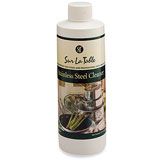 Sur La Table Stainless Steel Cleaner is another nontoxic, biodegradable option for removing tough grime and polishing your stainless steel appliances and gadgets.
Sur La Table Stainless Steel Cleaner is another nontoxic, biodegradable option for removing tough grime and polishing your stainless steel appliances and gadgets.
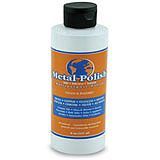 Homewood Metal Polish also contains only natural and plant-based ingredients. Because it’s a multi-purpose metal cleaner, it might be a good choice if you have more metals to clean than just stainless steel. It’s even safe to use on silver, pewter, and bronze. You can order bottles of Metal Polish from Amazon.
Homewood Metal Polish also contains only natural and plant-based ingredients. Because it’s a multi-purpose metal cleaner, it might be a good choice if you have more metals to clean than just stainless steel. It’s even safe to use on silver, pewter, and bronze. You can order bottles of Metal Polish from Amazon.